| |
Annotated slides - Part 1
Digital Art Museum is privileged to have received a set of annotated
slides from Hébert, which document the development of his work since 1979.
As well as a detailed and personal account of his art, the texts also
provide us with an insight into the technical developments that have underpinned
digital fine art since that time.
"Such approach to linear divisions of the plane
where reasoning came to conclusions reminding of earlier purely aesthetic
researches by the Bauhaus, the Constructivists, de Stilj was exhilarating.
I was not discouraged by the idea of being a late follower: I was not,
I had my own ways and goals in mind." - Hébert
Copyright information
|
|
|
|
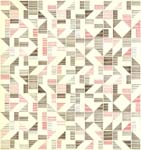
Slide #1 1979/ I from the series "Triangulated
Chances"/ drawing, ink on paper/ 7"x7" This was my first attempt
to produce drawings using a small table plotter to draw lines in
a pattern I had conceived and defined by a short text, a computer
program I had written in Basic. Some definitions were randomized
and with the same program I produced six little studies in red and
black, which I later recognized to be in the style of several pieces
by Anni Abers and titled accordingly.
|
 |
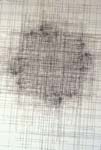
Slide #2/ 1984 untitled study/ drawing, ink
on paper/ 8"x8" Reading Benoit Mandelbrot's "The Fractal
Geometry of Nature" was a powerful inspiration. The geometry
of self similarities expanded the analytic resources applicable
to drawing. I had embarked in exploring in detail these new possibilities,
and was quickly beyond the text. Now endowed with a slightly larger
device, I started using good papers, permanent inks and better pens.
This study was a step in the discovery of dynamic patterns of line
generated from recursive formulations. Only small 'paradigm'
research studies are shown here in slides #2-#8: I was trying more
ambitious work but was not satisfied yet.
|
| |
| |
|
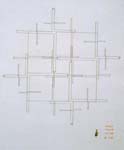
Slide #3/ 1985 untitled study/ drawing, ink
on paper/ 8"x14" Now came the time to tame the fractal paradigm
and flex it to accomplish my specific goals. Such approach to linear
divisions of the plane where reasoning came to conclusions reminding
of earlier purely aesthetic researches by the Bauhaus, the Constructivists,
de Stilj was exhilarating. I was not discouraged by the idea of
being a late follower: I was not, I had my own ways and goals in
mind.
|
|
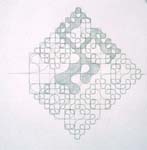
Slide #4/ 1985 untitled study/ drawing, ink
on paper/ 7"x7" Short fractal development showing a hand colored
division of the plane. These studies where produced by the tools
I was building, with the intent to check them and to evolve them,
to evolve my own understanding and define the needs for the task
at hand. I made hundreds of such studies, which almost never were
titled. They were also the visual reward, the answer and the riddle.
|
| |
| |
|

Slide #5/ 1986 untitled study/ drawing, ink
on paper/ 7"x7" Fractal development showing a spontaneous and
rhythmic division of the plane, provided by a careful selection
of the underlying geometries.
|
|
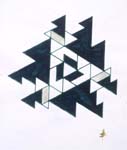
Slide #6/ 1986 untitled study/ drawing, ink
on paper/ 7"x7" Short fractal development showing a hand colored
division of the plane based on triangular symmetries and expansions.
The coloring both underlines and breaks the inherent self similarities.
|
| |
| |
|
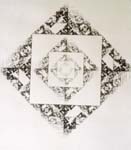
Slide #7/ 1987 untitled study/ drawing, ink
on paper/ 7"x7" Fractal development plane covering, binary division
of the plane and gray effects. The elegance of the paradigm is that
the concept of a piece can be described in a very compact manner,
whereby a rather short piece of text will encode a multitude of
geometrical elements and provide for perfectly accurate and complex
pen work.
|
|

Slide #8/ 1987 untitled study/ drawing, ink
on paper/ 7"x7" Here several affine transformations and several
inks combine to increase the dynamics of a fractal line, and create
in fact a second level of composition. I quickly abandoned this
direction of work, although I found the result pleasing, simply
because I could never anticipate the final outcome of such compositions.
|
| |
| |
| |
|
Annotated
Slides Page Two |
|

